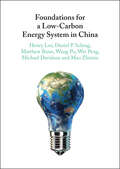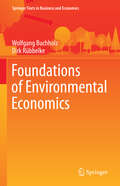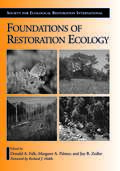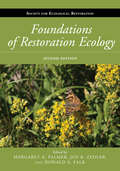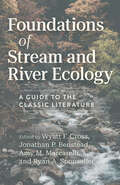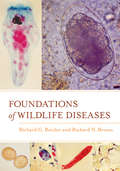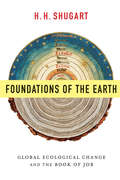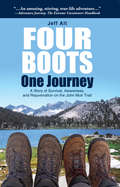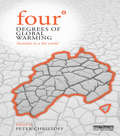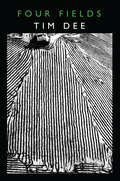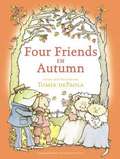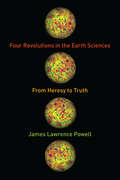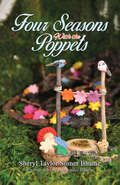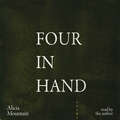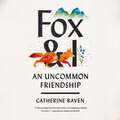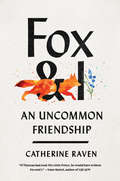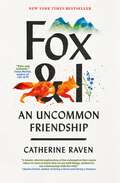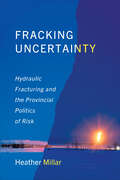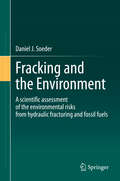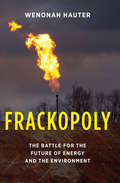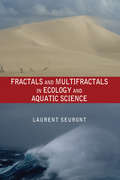- Table View
- List View
Foundations for a Low-Carbon Energy System in China
by Michael Davidson Henry Lee Matthew Bunn Wei Peng Daniel P. Schrag Wang Pu Mao ZhiminClimate change is a key problem of the 21st century. China, as the largest emitter of greenhouse gases, has committed to stabilize its current emissions and dramatically increase the share of electricity production from non-fossil fuels by 2030. However, this is only a first step: in the longer term, China needs to aggressively strive to reach a goal of zero-emissions. Through detailed discussions of electricity pricing, electric vehicle policies, nuclear energy policies, and renewable energy policies, this book reviews how near-term climate and energy policies can affect long-term decarbonization pathways beyond 2030, building the foundations for decarbonization in advance of its realization. Focusing primarily on the electricity sector in China - the main battleground for decarbonization over the next century – it provides a valuable resource for researchers and policymakers, as well as energy and climate experts.
Foundations of Environmental Economics (Springer Texts in Business and Economics)
by Wolfgang Buchholz Dirk RübbelkeThis textbook provides a solid introduction to the theoretical and empirical aspects of environmental economics, and their links to environmental policy. It advocates drawing on the economist’s toolbox as a powerful means of finding solutions to environmental problems by addressing the conflict between the societal costs of pollution on the one hand, and the financial costs of emissions reduction on the other. The book presents the main economic theory approaches to handling environmental problems and assessing the monetary value of environmental quality; the most relevant environmental policy instruments and challenges involved in their effective real-world application; and both national and global environmental problems addressed by environmental negotiations and agreements. Given its scope, the book offers a valuable basis of information for students, and for policymakers pursuing effective environmental policies.
Foundations of Restoration Ecology (Science Practice Ecological Restoration)
by Richard J. Hobbs Joy Zedler Margaret Palmer Donald A. FalkAs the practical application of ecological restoration continues to grow, there is an increasing need to connect restoration practice to areas of underlying ecological theory. Foundations of Restoration Ecology is an important milestone in the field, bringing together leading ecologists to bridge the gap between theory and practice by translating elements of ecological theory and current research themes into a scientific framework for the field of restoration ecology.Each chapter addresses a particular area of ecological theory, covering traditional levels of biological hierarchy (such as population genetics, demography, community ecology) as well as topics of central relevance to the challenges of restoration ecology (such as species interactions, fine-scale heterogeneity, successional trajectories, invasive species ecology, ecophysiology). Several chapters focus on research tools (research design, statistical analysis, modeling), or place restoration ecology research in a larger context (large-scale ecological phenomena, macroecology, climate change and paleoecology, evolutionary ecology).The book makes a compelling case that a stronger connection between ecological theory and the science of restoration ecology will be mutually beneficial for both fields: restoration ecology benefits from a stronger grounding in basic theory, while ecological theory benefits from the unique opportunities for experimentation in a restoration context.Foundations of Restoration Ecology advances the science behind the practice of restoring ecosystems while exploring ways in which restoration ecology can inform basic ecological questions. It provides the first comprehensive overview of the theoretical foundations of restoration ecology, and is a must-have volume for anyone involved in restoration research, teaching, or practice.
Foundations of Restoration Ecology (The Science and Practice of Ecological Restoration Series)
by Donald A. Falk Joy B. Zedler Karen Holl Margaret A. PalmerThe practice of ecological restoration, firmly grounded in the science of restoration ecology, provides governments, organizations, and landowners a means to halt degradation and restore function and resilience to ecosystems stressed by climate change and other pressures on the natural world. Foundational theory is a critical component of the underlying science, providing valuable insights into restoring ecological systems effectively and understanding why some efforts to restore systems can fail. In turn, on-the-ground restoration projects can help to guide and refine theory, advancing the field and providing new ideas and innovations for practical application.This new edition of Foundations of Restoration Ecology provides the latest emerging theories and ideas in the science of restoration ecology. Fully one-third longer than the first edition and comprehensive in scope, it has been dramatically updated to reflect new research. Included are new sections devoted to concepts critical to all restoration projects as well as restoration of specific ecosystem processes, including hydrology, nutrient dynamics, and carbon. Also new to this edition are case studies that describe real-life restoration scenarios in North and South America, Europe, and Australia. They highlight supporting theory for restoration application and other details important for assessing the degree of success of restoration projects in a variety of contexts. Lists at the end of each chapter summarize new theory introduced in that chapter and its practical application.Written by acclaimed researchers in the field, this book provides practitioners as well as graduate and undergraduate students with a solid grounding in the newest advances in ecological science and theory.
Foundations of Stream and River Ecology: A Guide to the Classic Literature
by Nancy B. GrimmFor students and practitioners, a comprehensive primer on the key literature in stream and river ecology. The study of streams and rivers combines ecology, chemistry, hydrology, and geology to reveal the factors that control the biological diversity and functioning of these unique ecosystems. Although stream ecology is a relatively young discipline, foundational papers published over the past half century have shaped our current understanding of these ecosystems and have informed our efforts to manage and protect them. Organized by topics such as the physical template, community structure, food webs, ecosystem energetics, and nutrient dynamics, the chapters of this book offer summaries of the key literature, historical and contextual information, and insightful discussions of how past research has influenced present studies and may shape future work.
Foundations of Wildlife Diseases
by Richard N. Brown Richard G. BotzlerFoundations of Wildlife Diseases is a comprehensive overview of the basic principles that govern the study of wildlife diseases. The authors integrate theoretical foundations with a thorough examination of the factors that can affect the health and fitness of animals. They include specific information on a wide array of infectious agents such as bacteria, viruses, arthropods, fungi, protista, and helminths, as well as immunity to these agents. Also provided is a foundation for the study of noninfectious diseases, cancers, and prion diseases that affect wildlife. Supporting students, faculty, and researchers in areas related to wildlife management, biology, and veterinary sciences, this volume fills an important gap in wildlife disease resources, focusing on mammalian and avian wildlife while also considering reptiles and amphibians.Foundations of Wildlife Diseases provides students with a structure for thinking about and understanding infective agents and their interactions with wildlife. Each chapter includes an outline, select definitions and concepts, an overview and summary, and literature cited.
Foundations of the Earth: Global Ecological Change and the Book of Job
by H.H. Shugart"Where were you when I laid the foundation of the earth?" God asks Job in the "Whirlwind Speech," but Job cannot reply. This passage—which some environmentalists and religious scholars treat as a "green" creation myth—drives renowned ecologist H. H. Shugart's extraordinary investigation, in which he uses verses from God's speech to Job to explore the planetary system, animal domestication, sea-level rise, evolution, biodiversity, weather phenomena, and climate change. Shugart calls attention to the rich resonance between the Earth's natural history and the workings of religious feeling, the wisdom of biblical scripture, and the arguments of Bible ethicists. The divine questions that frame his study are quintessentially religious, and the global changes humans have wrought on the Earth operate not only in the physical, chemical, and biological spheres but also in the spiritual realm. Shugart offers a universal framework for recognizing and confronting the global challenges humans now face: the relationship between human technology and large-scale environmental degradation, the effect of invasive species on the integrity of ecosystems, the role of humans in generating wide biotic extinctions, and the future of our oceans and tides.
Four Boots-One Journey: A Story of Survival, Awareness & Rejuvenation on the John Muir Trail
by Jeff AltOriginally published as an award-winning paperback: A Hike for Mike. Jeff Alt takes you vicariously along the John Muir Trail, on an entertaining adventure, with his new wife, Beth. Jeff convinces Beth, a woman who prefers hotels, hot showers and warm beds to chuck her domesticated ways and hike over 218-miles which leads to lots of humorous moments. Together, they traverse three national parks, including the highest mountain in the contiguous United States, Mt. Whitney. Jeff is compelled to take Beth on a hike after her brother tragically dies by suicide. Jeff thinks the hike will do Beth some good. They walk in her brother's memory as a depression awareness campaign. The Alt's journey is full of inspiration and adventure; from menacing bears, to lightning bolts, mountain lions, food shortages, and altitude sickness. Beth discovers the trials and joy of backpacking and they emerge from the trail rejuvenated.
Four Degrees of Global Warming: Australia in a Hot World
by Peter ChristoffAt Copenhagen in December 2009, the international community agreed to limit global warming to below two degrees Celsius to avoid the worst impacts of human-induced climate change. However climate scientists agree that current national emissions targets collectively will still not achieve this goal. Instead, the ‘ambition gap’ between climate science and climate policy is likely to lead to average global warming of around four degrees Celsius by or before 2100. If a ‘Four Degree World’ is the de facto goal of policy, we urgently need to understand what this world might look like. Four Degrees of Global Warming: Australia in a Hot World outlines the expected consequences of this world for Australia and its region. Its contributors include many of Australia’s most eminent and internationally recognized climate scientists, climate policy makers and policy analysts. They provide an accessible, detailed, dramatic, and disturbing examination of the likely impacts of a Four Degree World on Australia’s social, economic and ecological systems. The book offers policy makers, politicians, students, and anyone interested climate change, access to the most recent research on potential Australian impacts of global warming, and possible responses.
Four Fields
by Tim DeeIn this book, Tim Dee tells the story of four green fields spread around the world: their grasses, their hedges, their birds, their skies, and both their natural and human histories. These four fields-walkable, mappable, man-made, mowable, knowable, but also secretive, mysterious, wild, contested, and changing-play central roles in the sweeping panorama of world history and in the lives of individuals. In Dee's telling, a field is never just a setting for great battles or natural disasters, though it is often this as well. A field is the oldest and simplest and truest measure of what a man needs in life, especially when looked at, contemplated, worked in, lived with, and written about.Dee's four fields, which he has known and studied for more than twenty years, are the fen field at the bottom of his private garden, a field in southern Zambia, a prairie in Little Bighorn, Montana, and a grass meadow in the Exclusion Zone at Chernobyl, Ukraine. Meditating on these four fields, Dee makes us look anew at where we live and how. He argues that we must attend to what we have made of the wild.
Four Friends in Autumn
by Tomie DepaolaIt's a beautiful fall day -- perfect for dinner with friends. But will it ever be time to eat? It's autumn! The air is cool and crisp, and the leaves have changed to bright golds and reds. Mistress Pig wants to celebrate her favorite season by cooking a big feast for her friends. Mister Frog, Missy Cat, and Master Dog can't wait to taste all the delicious food. But why is it taking so long for Mistress Pig to come out of the kitchen? You'll never believe what happened to dinner! Join Tomie dePaola's beloved characters as they realize that every meal tastes better when served with a healthy dollop of friendship.
Four Revolutions in the Earth Sciences
by James Lawrence PowellJames Lawrence Powell serves as executive director of the National Physical Science Consortium, a partnership among government agencies and laboratories, industry, and higher education dedicated to increasing the number of American citizens with graduate degrees in the physical sciences and related engineering fields, emphasizing recruitment of a diverse applicant pool that includes women and minorities. He received his Ph.D from the Massachusetts Institute of Technology and has taught at Oberlin College and served as its acting president. He has also been president of Franklin and Marshall College, Reed College, the Franklin Institute Science Museum in Philadelphia, and the Los Angeles County Museum of Natural History. Presidents Ronald Reagan and George H. W. Bush both appointed Powell to the National Science Board. He is also the author of The Inquisition of Climate Science.
Four Revolutions in the Earth Sciences: From Heresy to Truth
by James Lawrence PowellJames Lawrence Powell serves as executive director of the National Physical Science Consortium, a partnership among government agencies and laboratories, industry, and higher education dedicated to increasing the number of American citizens with graduate degrees in the physical sciences and related engineering fields, emphasizing recruitment of a diverse applicant pool that includes women and minorities. He received his Ph.D from the Massachusetts Institute of Technology and has taught at Oberlin College and served as its acting president. He has also been president of Franklin and Marshall College, Reed College, the Franklin Institute Science Museum in Philadelphia, and the Los Angeles County Museum of Natural History. Presidents Ronald Reagan and George H. W. Bush both appointed Powell to the National Science Board. He is also the author of The Inquisition of Climate Science.
Four Revolutions in the Earth Sciences: From Heresy to Truth
by James PowellOver the course of the twentieth century, scientists came to accept four counterintuitive yet fundamental facts about the Earth: deep time, continental drift, meteorite impact, and global warming. When first suggested, each proposition violated scientific orthodoxy and was quickly denounced as scientific—and sometimes religious—heresy. Nevertheless, after decades of rejection, scientists came to accept each theory. The stories behind these four discoveries reflect more than the fascinating push and pull of scientific work. They reveal the provocative nature of science and how it raises profound and sometimes uncomfortable truths as it advances. For example, counter to common sense, the Earth and the solar system are older than all of human existence; the interactions among the moving plates and the continents they carry account for nearly all of the Earth's surface features; and nearly every important feature of our solar system results from the chance collision of objects in space. Most surprising of all, we humans have altered the climate of an entire planet and now threaten the future of civilization. This absorbing scientific history is the only book to describe the evolution of these four ideas from heresy to truth, showing how science works in practice and how it inevitably corrects the mistakes of its practitioners. Scientists can be wrong, but they do not stay wrong. In the process, astonishing ideas are born, tested, and over time take root.
Four Seasons with the Poppets
by Sheryl Taylor Sinner BhameAs with any enduring fairy tale, children will want to listen to Four Seasons with the Poppets again and again, to revisit the charming world of the Poppets. The seasonal stories speak to a child’s senses, describing picturesque scenes. In spring, how pretty the forest looked when the flowers were in bloom; in summer, the animals would come visit to hear Margie’s and Millie’s songs; in fall, gathering pine cones for Mother Poppet’s fires; in winter, ‘The roasted acorn smelled just like Christmas dinner should smell.’ Throughout the story are life lessons: appreciation for and conservation of the world around them, inclusion and encouragement of others, teamwork, and neighbourliness. Children are comforted, learning about the continuity of the seasons. “When Father Poppet saw how the sun made the frozen creek look like a sparkling white path, he decided to whittle ice skates for the children next spring, out of soft green wood, that would dry and harden in time for Christmas next winter.” When children use their imagination, it develops their ability to problem solve.
Four in Hand (American Poets Continuum Series #198)
by Alicia MountainComprised of four heroic crowns of sonnets, Alicia Mountain’s Four in Hand is both formal and experimental, ranging from lyric romantic and familial narratives to blank verses of reconfigured found text pulled from financial newsletter emails. Language and white space equally captivate with their sparsity and abundance as Mountain pursues the implications of national political identity with intersectional awareness. These poems interrogate our collective complicity in late-stage capitalism, drone warfare, the election of Donald Trump, environmental degradation, mental health crises, and the dawn of Covid-19 through the lens of gay poetic lineage, regionalism, and familial kinships structures.As in all lived experiences, treacheries and triumphs fade in and out of focus and intimacy, heartbreak, travel, eroticism, joy, and quotidian happenings offer character and momentum across non-linear narrative arcs. Through enthralling images, gripping storytelling, and world-building, Four in Hand carves out necessary space for lesbian gaze, speakership, and personhood. From the back corner of a vast, sprawling, yet gorgeous landscape of thought, Mountain's poems beckon us inside.
Fox and I: An Uncommon Friendship
by Catherine Raven Spiegal LlcINSTANT NEW YORK TIMES BESTSELLER"If there's one book you pick up this summer, make it this one." - Washington Post"A wise and intimate book about a solitary woman, a biologist by training, who befriends a fox." - Yann Martel, author of Life of PiCatherine Raven has lived alone since the age of 15. After finishing her PhD in biology, she built herself a tiny cottage on an isolated plot of land in Montana, in a place as far away from other people as possible. She viewed the house as a way station, a temporary rest stop where she could gather her nerves and fill out applications for what she hoped would be a real job that would help her fit into society.Then one day she realises she has company: a mangy-looking fox who starts showing up at her house every afternoon at 4.15pm. She has never had a visitor before. How do you even talk to a fox? She brings out her camping chair, sits as close to him as she dares, and begins reading to him from The Little Prince. Her scientific training has taught her not to anthropomorphise animals, yet as she grows to know him, his personality reveals itself and the two form a powerful bond - shaken only when natural disaster threatens to destroy their woodland refuge.Fox and I is a story of survival and transformation, a captivating tale of a friendship between two species in a shared habitat, battling against the uncontainable forces of nature on one side and humanity on the other - immersive, original and utterly unforgettable.
Fox and I: An Uncommon Friendship
by Catherine RavenA solitary woman’s inspiring, moving, surprising, and often funny memoir about the transformative power of her unusual friendship with a wild fox, a new window into the natural world, and the introduction of a remarkable literary talent. <P><P> Catherine Raven left home at fifteen, fleeing an abusive, disdainful father and an indifferent mother. More comfortable in nature than among people, she worked as a National Park ranger, eventually earning a PhD in biology. She built a house on an isolated plot of land in Montana, teaching remotely and leading field classes. One day, she realized that the mangy-looking fox who had been appearing on her property was now showing up every day at 4:15 p.m. She had never had a regular visitor before. <P><P> How do you even talk to a fox? So, she brought out her camping chair, sat as close to him as she dared, and began reading to him from The Little Prince. Her scientific training had taught her not to anthropomorphize animals, but as she grew to know him, his personality revealed itself—and he became her friend. But friends cannot always save each other from the uncontained forces of nature. Fox and I is a poignant and dramatic tale of friendship, transformation, and coping with inevitable loss—and of how that loss can become meaningful. It is also the introduction of an original, imaginative, stunning literary voice. <P><P><b>A New York Times Best Seller</b>
Fox and I: An Uncommon Friendship
by Catherine Raven Spiegal & LLCINSTANT NEW YORK TIMES BESTSELLER"If there's one book you pick up this summer, make it this one." - Washington Post"A wise and intimate book about a solitary woman, a biologist by training, who befriends a fox." - Yann Martel, author of Life of PiCatherine Raven has lived alone since the age of 15. After finishing her PhD in biology, she built herself a tiny cottage on an isolated plot of land in Montana, in a place as far away from other people as possible. She viewed the house as a way station, a temporary rest stop where she could gather her nerves and fill out applications for what she hoped would be a real job that would help her fit into society.Then one day she realises she has company: a mangy-looking fox who starts showing up at her house every afternoon at 4.15pm. She has never had a visitor before. How do you even talk to a fox? She brings out her camping chair, sits as close to him as she dares, and begins reading to him from The Little Prince. Her scientific training has taught her not to anthropomorphise animals, yet as she grows to know him, his personality reveals itself and the two form a powerful bond - shaken only when natural disaster threatens to destroy their woodland refuge.Fox and I is a story of survival and transformation, a captivating tale of a friendship between two species in a shared habitat, battling against the uncontainable forces of nature on one side and humanity on the other - immersive, original and utterly unforgettable.
Foxes (Worldlife Library)
by David MacdonaldFoxes, members of the wild dog family, have long been associated with intelligence and cunning, and they are an integral part of folklore. Worldwide they comprise a group of more than twenty species, all characterized by grace and adaptability. Because they are closely related to domestic dogs, they are seemingly familiar, yet their wildness makes them mysterious. Foxes is a comprehensive guide to the history, evolution, distribution, and social structure of foxes worldwide, from the red fox--the most widely distributed of any wild carnivore--to the Arctic fox--whose range encircles the North Pole--to Blanford's fox--a desert fox discovered in Israel. David Macdonald is Director of the Wildlife Conservation Research Unit at Oxford University and holds an A.D. White Professorship at Cornell University and a Senior Research Fellowship at Lady Margaret Hall, Oxford. He is acknowledged as a world expert on canids and is Chairman of the International United Commission for Nature Canid Specialist Group. Following a childhood fascination with wildlife, Macdonald's research on foxes began in 1972 with work that won the Zoological Society's Huxley Medal and has subsequently led him to publish papers on 15 different species of canid worldwide. He is also known for his documentary films and books, and has twice been awarded the Natural World Natural History Author of the Year Originally from Glasgow, David Macdonald lives with his wife and three children on their smallholding in Oxfordshire.
Fracking Uncertainty: Hydraulic Fracturing and the Provincial Politics of Risk (Studies in Comparative Political Economy and Public Policy)
by Heather MillarHydraulic fracturing – fracking – is an unconventional extraction technique used in the oil and gas industry that has fundamentally transformed global energy politics. In Fracking Uncertainty, Heather Millar explains variation in Canadian provincial policy approaches, which range from pro-development regulation to moratoria and outright bans. Millar argues that although regulatory designs are shaped by governments’ desires to seek out economic benefits or protect against environmental harms, policy makers’ perceptions of said benefits and/or harms are mediated through socially constructed narratives about uncertainty and risk. Fracking Uncertainty offers in-depth case studies of regulatory development in British Columbia, Alberta, New Brunswick, and Nova Scotia. Drawing on media analysis and interviews with government officials, industry representatives, academics, and environmental advocates, Millar demonstrates how risk narratives foster distinctive forms of learning in each province, leading to different regulatory reforms.
Fracking and the Environment: A scientific assessment of the environmental risks from hydraulic fracturing and fossil fuels
by Daniel J. SoederThis book provides a systematic scientific approach to the understanding of hydraulic fracturing (fracking) as a hydrocarbon extraction technology and its impact on the environment. The book addresses research from the past decade to assess how fracking can affect air, water, landscapes and ecosystems, and presents the subject in the context of the history of fracking and shale gas development in the United States, describing what is known and not known about environmental impacts, and the broader implications of fossil energy use, climate change, and technology development. In 9 chapters, the author lays out how and why hydraulic fracturing was developed, what driving forces existed at the beginning of the so-called "shale revolution", how success was achieved, and when and why public acceptance of the technology changed. The intended audience is scientific people who are concerned about fracking, but perhaps do not know all that much about it. It is also intended for lay people who would be interested in understanding the technical details of the process and what effects it might or might not be having on the environment. The book is written at a level that is both understandable and technically correct. A further goal is to give some useful insights even to experienced petroleum geologists and engineers who have been doing fracking for many years.
Fracking the Neighborhood: Reluctant Activists and Natural Gas Drilling (Urban and Industrial Environments)
by Jessica Smartt GullionWhat happens when natural gas drilling moves into an urban area: how communities in North Texas responded to the environmental and health threats of fracking.When natural gas drilling moves into an urban or a suburban neighborhood, a two-hundred-foot-high drill appears on the other side of a back yard fence and diesel trucks clog a quiet two-lane residential street. Children seem to be having more than the usual number of nosebleeds. There are so many local cases of cancer that the elementary school starts a cancer support group. In this book, Jessica Smartt Gullion examines what happens when natural gas extraction by means of hydraulic fracturing, or “fracking,” takes place not on wide-open rural land but in a densely populated area with homes, schools, hospitals, parks, and businesses. Gullion focuses on fracking in the Barnett Shale, the natural-gas–rich geological formation under the Dallas–Fort Worth metroplex. She gives voice to the residents—for the most part educated, middle class, and politically conservative—who became reluctant anti-drilling activists in response to perceived environmental and health threats posed by fracking.Gullion offers an overview of oil and gas development and describes the fossil-fuel culture of Texas, the process of fracking, related health concerns, and regulatory issues (including the notorious “Halliburton loophole”). She chronicles the experiences of community activists as they fight to be heard and to get the facts about the safety of fracking.Touted as a greener alternative and a means to reduce dependence on foreign oil, natural gas development is an important part of American energy policy. Yet, as this book shows, it comes at a cost to the local communities who bear the health and environmental burdens.
Frackopoly: The Battle for the Future of Energy and the Environment
by Wenonah Hauter&“The definitive story on how big oil and gas corporations captured our political system . . . and the growing grassroots movement to retake our democracy&” (Mark Ruffalo). Over the past decade a new and controversial energy extraction method known as hydraulic fracturing, commonly referred to as fracking, has rocketed to the forefront of US energy production. With fracking, millions of gallons of water, dangerous chemicals, and sand are injected under high pressure deep into the earth, fracturing hard rock to release oil and gas. Wenonah Hauter, one of the nation&’s leading public interest advocates, argues that the rush to fracking is dangerous to the environment and treacherous to human health. Frackopoly describes how the fracking industry began; the technologies that make it possible; and the destruction and poisoning of clean water sources with the release of harmful radiation from deep inside shale deposits, creating what the author calls &“sacrifice zones&” across the American landscape. The book also examines the powerful interests that have supported fracking, including leading environmental groups, and offers a thorough debunking of its supposed economic benefits. With a wealth of new data, Frackopoly is an essential and riveting read for anyone interested in protecting the environment and ensuring a healthy and sustainable future for all Americans. &“A passionate history and critique of the energy industry, from Standard Oil to Enron . . . . [A] journalistic exposé of fracking outrages in which aggressive entrepreneurs in pursuit of profits wreak havoc on the land and poison the water.&” —Kirkus Reviews &“A truly powerful manifesto about one of the greatest environmental fights on our planet today—from one of its greatest champions!&” —Bill McKibben, environmentalist and author of Oil and Honey
Fractals and Multifractals in Ecology and Aquatic Science
by Laurent SeurontEcologists sometimes have a less-than-rigorous background in quantitative methods, yet research within this broad field is becoming increasingly mathematical. Written in a step-by-step fashion, Fractals and Multifractals in Ecology and Aquatic Science provides scientists with a basic understanding of fractals and multifractals and the techniques fo
